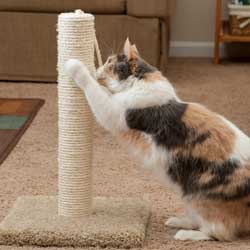Scratching is normal feline behavior. It’s part exercise and part “marking” behavior. Your cat stretches, has a nice vigorous scratch, and leaves the spot marked as “mine”. It also helps to rid the claws of old layers, but doesn’t really do much to sharpen the claws, as many people believe.
It is much easier to train your cat appropriate scratching behavior while he (or she) is still a kitten. This behavior begins about the time that your kitten is old enough to be weaned. Older cats can be trained also but usually require longer, especially if they were not conditioned to using a scratching post before. Just be persistent and gentle but firm.
You may have to experiment a bit to find scratching spots that appeal to your cat. A standard vertical post should be tall enough for your cat to stretch his full length, and should be very solid. Cats don’t like to use a wobbly post. Some cats especially like to use carpet covered cat “furniture” with posts, barrels, and platforms, since these are large enough, solid, and offer a variety of surfaces to claw. They also like to nap and play on the furniture, helping to reinforce the idea that it is theirs.
Some cats prefer to claw on a horizontal surface. Some will use sisal mats that they can stand on and claw. Many cats enjoy the inexpensive cardboard scratching boxes that lay flat on the floor. They often come with small bags of catnip to provide additional incentive. Some cats like to scratch rough wood, such as a log with the bark still on it.
Place the post or mat where the cat wants to use it. This is essential – a post placed in the basement next to the litter box won’t get used. Cats often like to stretch and scratch after sleeping, so place the post near favorite napping spots. Having several scratching spots around the house, wherever your cat likes to hang out, is a good way to encourage appropriate scratching behavior.
Use enticements such as rubbing catnip on scratching mats or by dangling a toy for him to grab around a post to help interest your cat in his new scratching spots. Don’t forget to reward him for a wanted behavior. Tell him what a good boy he is – he understands your tone of voice and the affectionate rub on his head. You can even reward him with treats.
If your cat starts to scratch on the sofa (or chair or bed), you need to let him know that this is not acceptable. A loud noise such as a clap or a word delivered in an authoritative voice generally gets a startle response, which interrupts the scratching. Then place him in front of his own scratching spot and praise him when he scratches there. Most cats get the message pretty quickly.




